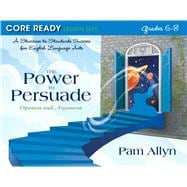Created specifically for middle school teachers, Pam Allyn’s dynamic Core Ready Program provides a complete toolkit for navigating and thriving with the core standards. In it teachers see clearly how to take complex concepts of the literacy standards and turn them into practical, specific, everyday instruction. The series is organized around the author’s Four Doors to the Core:
- The Journey to Meaning: Comprehension and Critique
- The Shape of Story: Yesterday and Today
- The Road to Knowledge: Information and Research
- The Power to Persuade: Opinion and Argument
Each book in the series includes powerful reading, writing, speaking, and listening sets; assessment rubrics; support for ELLs and diverse learners; and tips for doing high tech variations for literacy instruction for grades 6, 7, and 8.
Visit http://pdtoolkit.pearson.com to purchase access to the PDToolkit for Pam Allyn's Core Ready Series. The PDToolkit access does not come with the print book.
PDToolkit for Pam Allyn's Core Ready Series is a supplemental online subscription-based resource that provides the tools that educators need to implement the Common Core Standards effectively, fluidly, and successfully. The PDToolkit, together with the texts, provides the tools you need to ensure a standards-aligned year of joyful, effective, research-based literacy curriculum.








